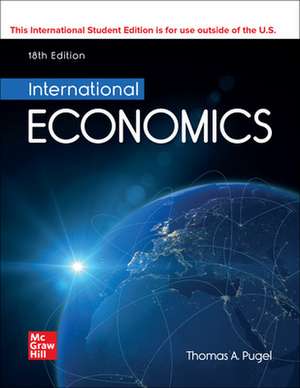International Economics ISE
Autor Thomas Pugelen Limba Engleză Paperback – 17 mar 2023
International Economics is thoroughly integrated with the adaptive digital tools available in McGraw-Hill’s Connect, proven to increase student engagement and success in the course. Connect is the only integrated learning system that empowers students by continuously adapting to deliver precisely what they need, when they need it, and how they need it, so that your class time is more engaging and effective.
Preț: 480.10 lei
Preț vechi: 607.72 lei
-21% Nou
Puncte Express: 720
Preț estimativ în valută:
91.88€ • 95.80$ • 76.36£
91.88€ • 95.80$ • 76.36£
Carte disponibilă
Livrare economică 24 februarie-01 martie
Livrare express 13-19 februarie pentru 52.81 lei
Preluare comenzi: 021 569.72.76
Specificații
ISBN-13: 9781266131752
ISBN-10: 1266131752
Pagini: 800
Dimensiuni: 185 x 231 x 28 mm
Greutate: 1.27 kg
Ediția:18
Editura: McGraw Hill Education
Colecția McGraw-Hill
Locul publicării:United States
ISBN-10: 1266131752
Pagini: 800
Dimensiuni: 185 x 231 x 28 mm
Greutate: 1.27 kg
Ediția:18
Editura: McGraw Hill Education
Colecția McGraw-Hill
Locul publicării:United States
Cuprins
Chapter 1: International Economics Is Different
Chapter 2: The Basic Theory Using Demand and Supply
Chapter 3: Why Everybody Trades: Comparative Advantage
Chapter 4: Trade: Factor Availability and Factor Proportions Are Key
Chapter 5: Who Gains and Who Loses from Trade?
Chapter 6: Scale Economies, Imperfect Competition, and Trade
Chapter 7: Growth and Trade
Chapter 8: Analysis of a Tariff
Chapter 9: Nontariff Barriers to Imports
Chapter 10: Arguments for and against Protection
Chapter 11: Pushing Exports
Chapter 12: Trade Blocs and Trade Blocks
Chapter 13: Trade and the Environment
Chapter 14: Trade Policies for Developing Countries
Chapter 15: Multinationals and Migration: International Factor Movements
Chapter 16: Payments among Nations
Chapter 17: The Foreign Exchange Market
Chapter 18: Forward Exchange and International Financial Investment
Chapter 19: What Determines Exchange Rates?
Chapter 20: Government Policies toward the Foreign Exchange Market
Chapter 21: International Lending and Financial Crises
Chapter 22: How Does the Open Macroeconomy Work?
Chapter 23: Internal and External Balance with Fixed Exchange Rates
Chapter 24: Floating Exchange Rates and Internal Balance
Chapter 25: National and Global Choices: Floating Rates and the Alternatives
APPENDIXES
A: International Numbers and Other Information
B: Deriving Production-Possibility Curves
C: Offer Curves
D: The Nationally Optimal Tariff
E: Accounting for International Payments
F: Many Parities at Once
G: Aggregate Demand and Aggregate Supply in the Open Economy
H: Devaluation and the Current Account Balance
Chapter 2: The Basic Theory Using Demand and Supply
Chapter 3: Why Everybody Trades: Comparative Advantage
Chapter 4: Trade: Factor Availability and Factor Proportions Are Key
Chapter 5: Who Gains and Who Loses from Trade?
Chapter 6: Scale Economies, Imperfect Competition, and Trade
Chapter 7: Growth and Trade
Chapter 8: Analysis of a Tariff
Chapter 9: Nontariff Barriers to Imports
Chapter 10: Arguments for and against Protection
Chapter 11: Pushing Exports
Chapter 12: Trade Blocs and Trade Blocks
Chapter 13: Trade and the Environment
Chapter 14: Trade Policies for Developing Countries
Chapter 15: Multinationals and Migration: International Factor Movements
Chapter 16: Payments among Nations
Chapter 17: The Foreign Exchange Market
Chapter 18: Forward Exchange and International Financial Investment
Chapter 19: What Determines Exchange Rates?
Chapter 20: Government Policies toward the Foreign Exchange Market
Chapter 21: International Lending and Financial Crises
Chapter 22: How Does the Open Macroeconomy Work?
Chapter 23: Internal and External Balance with Fixed Exchange Rates
Chapter 24: Floating Exchange Rates and Internal Balance
Chapter 25: National and Global Choices: Floating Rates and the Alternatives
APPENDIXES
A: International Numbers and Other Information
B: Deriving Production-Possibility Curves
C: Offer Curves
D: The Nationally Optimal Tariff
E: Accounting for International Payments
F: Many Parities at Once
G: Aggregate Demand and Aggregate Supply in the Open Economy
H: Devaluation and the Current Account Balance
